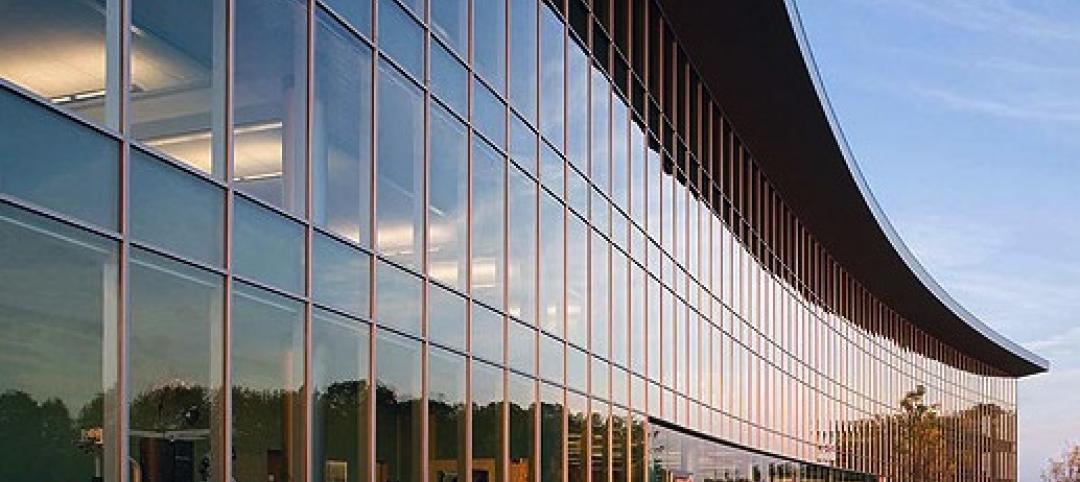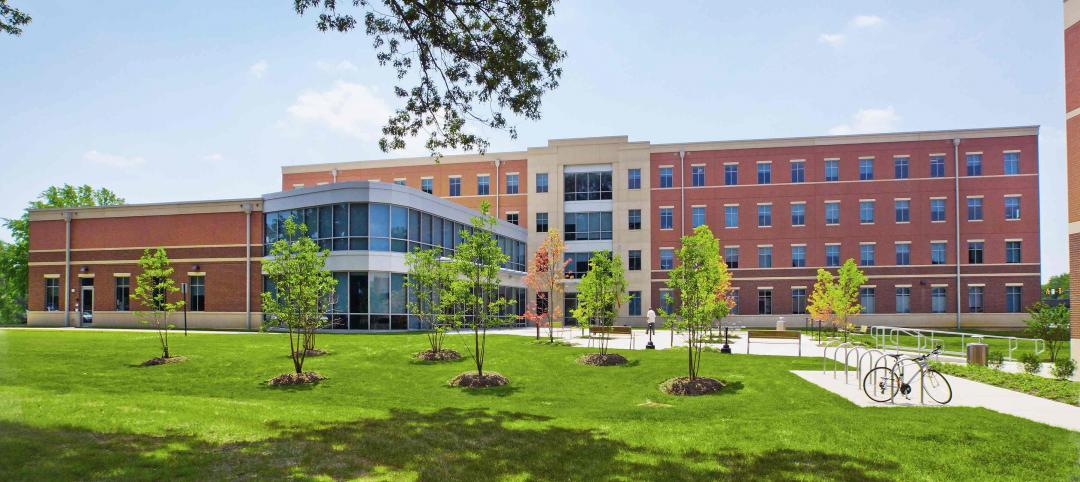 |
| The solar shade of the Art Institute of Chicago’s Modern Wing was designed to collect and redirect natural light from the north and filter out intense southern light. |
Italian architect Renzo Piano refers to his $294 million, 264,000-sf Modern Wing of the Art Institute of Chicago as a “temple of light.” That's all well and good, but how did Piano and the engineers from London-based Arup create an almost entirely naturally lit interior while still protecting the priceless works of art in the Institute's third-floor galleries from dangerous ultraviolet rays?
Piano addressed that concern by hanging a 216-foot-wide “flying carpet” canopy over the glazed roof of the Modern Wing's east building to filter light and eliminate the threat to the art. This sunshield, supported by steel bracings above the museum's third-floor galleries, is composed of thousands of extruded aluminum “blades” precisely angled to collect and redirect natural light from the north and filter out the dangerous and more intense southern light. Additional screening and computer-adjusted electrical lighting achieve the ideal combination of appropriate lighting, reduced electrical expenses, and art preservation. All of this contributed to the Modern Wing, which opened last May, achieving LEED Silver certification.
“This is made easier in a city that is built on precise north-south and east-west axes, perfectly in tune with the cycle of the sun, like a solar machine,” Piano wrote in notes to his original Modern Wing drawings.
 |
| The sprawling sunshade also shields patrons from the sun on the Art Institute’s third-floor, 3,400-sf viewing deck that leads to a bridge to nearby Millennium Park, seen here from the viewing deck. The bridge was also designed by Renzo Piano. |
Robert Lang, lead structural engineer on the project, has been with Arup for 27 years and has spent 20 of those years working with Piano on his projects. He's worked on similar shading and screening devices for Piano's designs of the Los Angeles County Museum of Art, the Lingotto Factory Conversion in Turin, Italy, and the Beyeler Foundation near Basel, Switzerland.
The blades are roughly 13-and-a-half feet long and are situated very crudely at an angle of 45 degrees, says Lang. “They are sculpted and shaped so that they're structurally stable,” he says. “At the low end they're open to the north to allow the indirect northern light in. At the east and west ends they have a series of fins attached to them to catch and block southern light.”
There are more than two thousand small blades on the 46,600-sf “flying carpet,” each supported at two anchor points. The blades were computer-modeled by Arup for maximum energy efficiency and custom fabricated by Sapa RC Profiles in Belgium, which shipped each blade to the site ready for installation. Inside the Modern Wing, a finely calibrated dimming system uses photocells to adjust the supplied lighting to fluctuations in daylighting levels according to time of day, season, and weather. The ceiling and roof of the Modern Wing have two layers of glass and two separate shading systems.
 |
| This sketch by architect Renzo Piano shows how building orientation was used to gather and take advantage of northern light at the Art Institute. |
All of Piano's shading devices share common elements from project to project, but the Art Institute's solar shade had to be specially reinforced to withstand changing temperatures and winds of the city's lakefront. “The climate in Chicago, being as severe as it is, was a concern,” says Lang. “For the force of wind, the blades were designed to withstand movement due to high wind by heavy anchoring in the two positions they were affixed to.” Horizontal directional movement was less than 1.1 inches.
“When it comes to temperature fluctuation, we basically allowed the shade structure to expand and contract due to temperature, always away from the center,” says Lang. “The ends of the roof need to be quite large, and the steelwork was anchored to the support polls and outer walls, one solidly, the other less solidly, to allow for expansion and contraction.”
Each of Piano's Modern Wing flying carpet canopies extends its edge panels out past the last supporting side of the building below to increase the sense of lightness, so the solar shade appears to dissolve at its endpoint. Each roof beam supporting the Art Institute's flying carpet was fabricated offsite and sent to the site as a single piece to be installed.
 |
| This photo of the ceiling of the East Building, taken during construction, shows the rooftop blades without interior shades below the glass roof. |
Inside each beam is a prestressed steel joint that was joined onsite to the lower structure or another beam. Each beam had to be installed in sequence, as the beams make up a web of tolerances that all depend on one another. The intricate web spun by Piano created the desired look of openness and weightlessness.
“I think the story we are telling with the new addition is about accessibility,” Piano wrote in his notes about the addition. “It's about openness. It's about a building that should not be intimidating.”
Related Stories
| Jul 23, 2013
Paul Bertram to speak at ACEEE Summer Study on Energy Efficiency
Paul Bertram, FCSI, CDT, LEED AP and director of environment and sustainability for Kingspan Insulated Panels N.A., will present a white paper during the American Council for an Energy Efficient Economy (ACEEE) 2013 Summer Study on Energy Efficiency in Industry.
High-rise Construction | Jul 9, 2013
5 innovations in high-rise building design
KONE's carbon-fiber hoisting technology and the Broad Group's prefab construction process are among the breakthroughs named 2013 Innovation Award winners by the Council on Tall Buildings and Urban Habitat.
| Jun 28, 2013
Calculating the ROI of building enclosure commissioning
A researcher at Lawrence Berkeley National Laboratory calls building enclosure commissioning “the single-most cost-effective strategy for reducing energy, costs, and greenhouse gas emissions in buildings today.”
| Jun 27, 2013
Thermal, solar control designs can impact cooling loads by 200%, heating loads by 30%
Underestimating thermal bridging can greatly undermine a building’s performance contributing to heating load variances of up to 30% and cooling load variances of up to 200%, says the MMM Group.
| May 17, 2013
5 things AEC pros need to know about low-e glass
Low-emissivity glasses are critical to making today’s buildings brighter, more energy-efficient, and more sustainable. Here are five tips to help AEC professionals understand the differences among low-e glasses and their impact on building performance.
| May 14, 2013
Easy net-zero energy buildings [infographic]
"Be a Zero Hero" infographic educates building industry professionals on ultra energy-efficient structural insulated panel construction
| May 8, 2013
Preventable curtain wall failures - AIA/CES course
In many cases, curtain wall failures are caused by fairly simple errors that occur during the fabrication and installation process. This presentation will highlight common errors and when they typically occur.
| Apr 16, 2013
5 projects that profited from insulated metal panels
From an orchid-shaped visitor center to California’s largest public works project, each of these projects benefited from IMP technology.
| Apr 10, 2013
23 things you need to know about charter schools
Charter schools are growing like Topsy. But don’t jump on board unless you know what you’re getting into.















